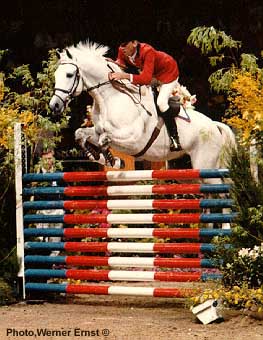
Show-jumping

The three modern
Olympic equestrian sports are show-jumping, dressage and eventing. The
origins of show-jumping lie in hunting. At the Dublin Show in 1868, a
"high leap" and a "wide leap" were first used to test horses
for the hunting field. In 1881 a permanent jumping course was built there
and show-jumping began to develop as a sport in its own right. In France
in 1900, jumping competitions were held with the Olympic Games.
________________________________________________________________________________________
Jumping contests are scored on performance only. A horse of any
description can win if he takes more jumps more soundly than the
competition. His rider's style--or lack of it--does not count, although
the rider's skill is crucial to winning. Events are decided as surviving
horses jump repeated rounds over higher and higher barriers.
Some shows have classes for maiden, novice, and limit
jumpers, but ordinarily horses are grouped as either green or open
jumpers. Green jumpers are those that have not been shown in the Jumper
Division at a recognized show earlier than January 1st of the current
year. They are tested over jumps of about 3 feet 9 inches. Open
jumpers are those shown--usually by professional riders--in the open-to-all
class. These are seasoned horses for whom six-foot jumps are everyday
work.
A typical course tests the horse's pacing with barriers
placed at irregular intervals; it tests his calm with obstacles that are
visually alarming, such as brightly painted barrels; it tests his power and
co-ordination with vertical or broad jumps of increasing difficulty.
The winner in a jumping class is the horse that has committed
the fewest faults. Under AHSA rules there is a specified penalty for every
fault, such as touching an obstacle, knocking it down, refusing a jump, etc.
Some shows judge jumping competition according to the
international rules set down by the Fédération Equestre Internationale (the
FEI, of which the AHSA is a member). The two sets of rules diverge on many
points. Under AHSA rules, the time of a round is not usually a factor in
wining, nor is there any minimum weight to be carried by competing
jumpers. Elimination follows a fall by either horse or rider or
both. In shows governed by international rules, such as the Olympics and
the Pan American games, rounds are clocked, and jumpers must carry a specified
minimum weight; a fall costs the contestant eight faults, but not elimination,
and touches of the obstacles do not count.
Two traditional jumping events in American
shows are the
Touch-and-Out, in which the contestant is required to leave the ring as soon as
he touches an obstacle, and the Knock-Down-and-Out, in which he is put out for
knocking down an obstacle. In each event the rider with the highest tally
of clean jumps wins. The High Jump is a thrilling single-jump event in
which the barrier is gradually raised. Horses that fail to clear it in
three tries are eliminated. The winner is the horse that clears the
highest mark.
________________________________________________________________________________________
Television helps to maintain the enormous popularity show-jumping enjoys
today in Great Britain
and much of Europe. Thousands of otherwise "unhorseminded" people now know and follow the jumping
"stars," and interest
themselves in the different styles and successes. Trivia: Show
jumping was first televised in Great Britain
in 1948 during the Olympic Games at
Wembley, London.
Show-jumping standards are now so high that, even in small
shows, the grass-fed pony stands small chance of success. Practically all
are stables, corn-fed and expertly schooled.
Jumpers in the pony class must be 14.2 hands or under, with a
half-inch allowance for shoes. Ponies may compete against horses and be
ridden by adults in jumping competitions. However, most teenagers graduate
to horses when they reach the age limit. An exception was Marion Coakes,
1967 Ladies World Champion, who still rode the fantastic Thoroughbred
pony,
Stroller, with which she was so successful as a child.
A good show-jumper is courageous, with a natural aptitude and
liking for jumping. Suppleness and obedience are vital, and instilled by
schooling. It is believed that excessive jumping, particularly over
familiar fences, quickly discourages the horse. Many champion jumpers are
scarcely jumped between competitions; however, horses are individualists and
require different treatment.
Some horses prefer jumping comparatively slowly, other like
speed and enjoy going "against the clock"; some can attain astonishing heights,
although this is seldom favored by horsemen because it overexcites the horses.
Some show-jumpers give of their best at indoor arenas; others
appear constricted unless jumping outside. Many small animals win speed
contests, because they are handy at cutting corners and changing course quickly.
No show-jumper, however willing and experienced, can excel
unless it has confidence in its rider. Riders must learn the best approach
and take-off for particular fences, the distance between them, and how to judge
and lengthen or shorten their horse's stride. A rider must be 'in tune'
with his horse, and fully understand his capabilities and failings.